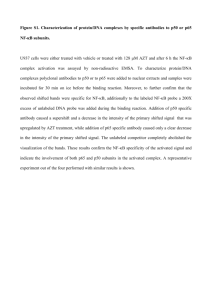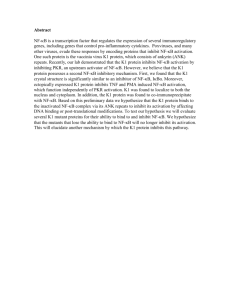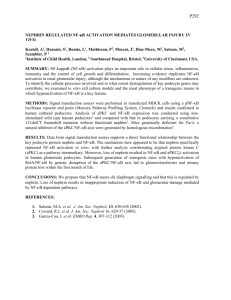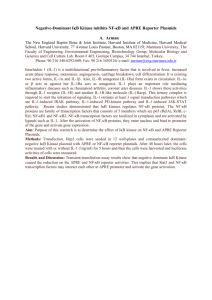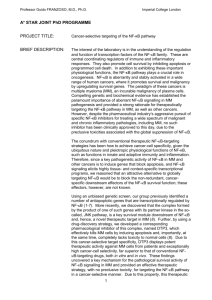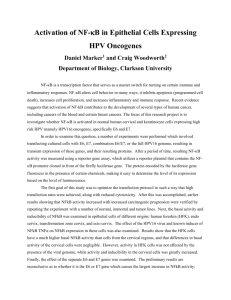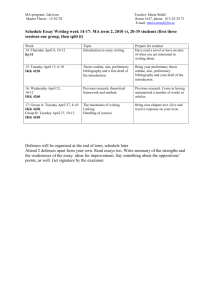Signaling pathways
advertisement
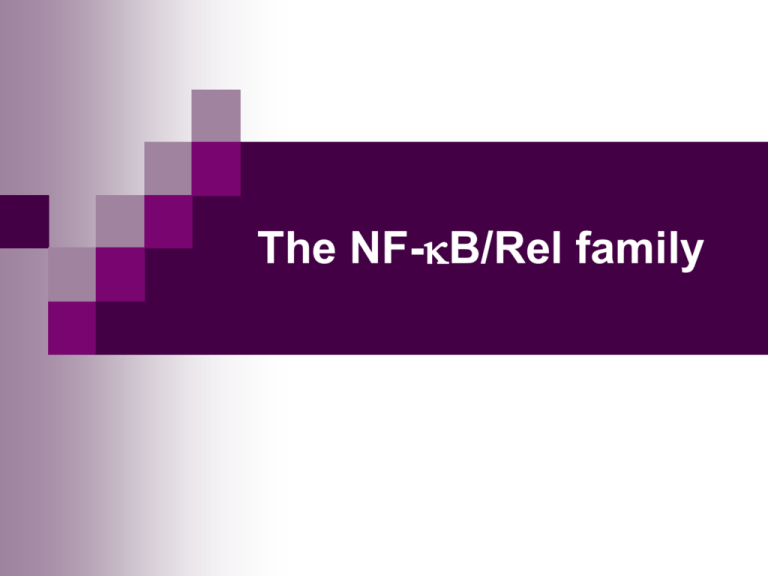
The NF-B/Rel family MBV4230 The NF-B/Rel family A family of signal-responsive transcription factors rapid response som ikke requires proteinsyntese Involved in proinflammatory response: a first line of defense against infectious diseases and cellular stress Signal Activated NF-B immune defence activated Immune response, inflammatory response, accute phase response NFkB also a major anti-apoptopic factor aberrant activation of NF-B = one of the primary causes of a wide range of human diseases like in Inflammatory diseases, Rheumatoid arthritis, Asthma, Atherosclerosis, Alzheimer Persistent activated in many cancers - help keeping them alive NFkB also promoting growth Activated NF-B cyclin D expression enhanced growth Drug against NFkB = putative anti-cancer drug MBV4230 The NF-B/Rel family Characteristic feature: homo- and heterodimeric TFs, which in non-stimulated cells are found inactive in the cytoplasm [in a complex with IB-repressors]. Active DNA-binding form: Dimers with different members of the NF-B/Rel family Inactive cytoplasmic form: inhibitory factor/domain in addition Upon stimulation, active NF-B rapidly translocates to the nucleus where it binds B-sites and activates target genes. Rapid response - minutes Signal Activated NF-B immune defence activated MBV4230 Signal transduction pathway Signals Cytoplasm inactive Nucleus active NF-B/Rel proteins MBV4230 Common DBD: Rel-homology domain (RHD) RHD: 300aa conserved domain with several functions DNA-binding (N-terminal half) dimerization (C-terminal half) IB-interaction (C-terminal half) NLS (C-terminal half) kalles også NRD (=NF-kB, Rel, Dorsal) Spec.DNA-binding dimerization IkB-interaction NLS MBV4230 Homo- and heterodimers NF-B/Rel proteins = Homo- and hetero-dimeric TFs that in resting cells are retained in the cytoplasm in complex with IB. Mature B-cells: constitutively nuclear activator Bound to kappa immunoglobuline lightchain enhancer its name MBV4230 Two main classes of RHDs Rel with TAD (dimeric with ≥ 1 Rel-monomers which are potent transactivators) synthesized in their mature form Rel or c-Rel (as well as v-Rel) RelA (p65) RelB Drosophilas dorsal and Dif p50/52 without TAD (homodimers with no transactivation properties) synthesized as precursors that are processed Precursor forms have internal IB inhibitor function RHD linked to inhibitory domain through Gly-rich linker (protease sensitive) Blocks DNA-binding and translocation to nucleus p105 undergoes proteolytic maturation to p50 [NF-B1] Proteolytic degradation to p50 is signal dependent, requires ATP and occurs through a ubiquitin-dependent proteasome pathway Also transcription from an intronic promoter expression of IkB- p100 undergoes proteolytic maturation to p52 [NF- B2] p50/52 are distinct gene products with very similar properties MBV4230 Two main classes of RHDs - TAD Rel homology domain p105 p50 C-terminal IB-like domains p100 +TAD p52 RelA(p65) cRel RelB Acitvation domains MBV4230 RHD proteins Ankyrin repeats RHD MBV4230 Dimer-formation Dimer-formation necessary for DNAbinding each subunit interacts with one half site B-sites symmetric: 5´-GGGRNNYYCC-3´ Most combinations allowed Different heterodimers vary with respect to preference for different kB-seter Kinetics of nuclear translocation p50/p65 rapid, p50/Rel slow abundance in different cells Exception: RelB which forms dimer only with p50/p52 Common form: p50/p65 (NF-kB1/RelA) most abundant, found in most cells –--5´-GGGRNNYYCC-3´-–- 3´-CCCYNNRRGG-5´-- MBV4230 3D structure - DNA interaction Crystal structures: p50-p50-DNA and p50-p65-DNA Two distinct domains 1. N-terminal - specific DNA contact Compact core in the form of an antiparalell -barrel from which loops protrude The loop between AB = recognition loop with base contacts in major groove Critical for specificity = R57-R59-E63 C62 responsible for redox-sensitivity 2. C-terminal domain responsible for dimerisation + nonspecific DNAphosphate contact C-terminal domain Conserved interphase explains why most heterodimers are possible N-terminal domain MBV4230 Structure: NFB (p50-p65) + DNA Side view • -barrel core with protrding loops • The AB loop = recognition loop • Specificity R57-R59-E63 • C62 redox-sensitivity MBV4230 3D structure - DNA interaction Characteristic features of DNA-interaction Each monomer contacts a separate half site “Closing jaws” mechanism for DNA-binding The protein encloses DNA Unusual strong binding (Kd = 10-12 M) Dissociation requires opening of the jaws through a flexible linker MBV4230 3D structure - protein interaction Interaction with HMGI(Y) IFN- promoter: HMGI(Y) binds AT-rich centre of B-sites in minor groove The structure contains a corresponding open space Interaction with IB IB binding in an opening over the dimer-interphase IB binding blocks DNA-binding due to steric effect ? due to hinge-effect ? due to induced change of geometry in C-terminal domain reduced non-specific DNA-binding? The I-B family MBV4230 The I-B proteins Ankyrin repeats N-terminal Regulatory domain MBV4230 The IB-family Inhibitory function impedes DNA-binding blocks NLS and abolish translocation to nucleus Several members (at least 7 mammalian) IB- and IB- IB-and IB- Bcl-3 p105 and p110 IkBR Specificity Ex. IkB- inhibits DNA-binding of p65/p50 but not of p50/p50 Common features: ankyrin-repeats which are necessary for RHD-interaction 30-33 aa motif repeated 3 - 7x C-terminal acidic-region necessary for inhibition of DNA-binding C-terminal PEST-sequence involved in protein-degradation MBV4230 NFB-IB complex IkB HMG I(Y) MBV4230 Signaling The chain of events in the canonical NFB signaling pathway MBV4230 Cytoplasmic retention due to interaction with IB-family proteins Two types of inactive complexes in the cytoplasm 1. Trimers = RHD-Homo-or heterodimers bound to an IB-repressor 2. Heterodimers = Rel-protein + unprocessed RHD-precursor (p105, p110) Model: Signal dissociation (?) and degradation Induction signal phosphorylation of both IB and p105 IB degradation or p105 processering active dimers that are translocated to the nucleus. One type of signal two N-terminal serines (S32 and S36) become phosphorylated Another type of signal two C-terminal serines become phosphorylated in p105 phosphorylation probably more a signal for degradation than for dissociation Ubiquitin-pathway involved Stimulation rapid degradation of IB complete after 10 min No traces of IB phosphorylation of IB multiubiquitylation in K21, K22 degradation through a ubiquitin-dependent proteasome pathway I presence of proteasome-inhibitors phosphorylated IkB remains associated with NFkB MBV4230 Several IB-factors with different properties IB-: Rapid transient response IB- best characterized all stimuli degradation of IB- ex: TNF-rapid and transient activation of NF-kB IB-: Sustained response Only certain stimuli degradation of IB- ex: LPS or IL-1degradation of both IB-and IB- activation of NFkB lasting for hours Bcl-3: repressor and activator inhibits certain complexes like a normal IB But may also associate with DNA-bound p50 and p52 dimers (lacking TAD) and provide transactivation properties Signaling pathways MBV4230 Upstream and downstream Upstream Signal transduction pathways + .. + NF-kB Downstream + .. MBV4230 Signaling The chain of events in the NFB signaling pathway The system = a total of 50 geneproducts, but only 1 component is regulated: the IKK complex MBV4230 Multiple signalling pathways activate NF-B Several signalling pathways converge by activation of NF-B NF-B respond to a broad range of different stimuli Virus infection (HIV, hepatite B), virus proteins (tax, E1A) and dsRNA Cytokines (TNF, IL-1 and IL-2) Bacterial LPS stimulation of antigen reseptor on B- and T-cells calcium ionophores protein synthesis inhibitors UV and X-ray sphingomylenase/ceramide phorbol esters nitrogen oxide MBV4230 One type of signaling hits I-B through phosphorylation Two N-terminal serines becomes phosphorylated TNF-signalling pathways: TNF-receptor TRADD/TRAF NIK IKK IB IB-kinase complex central in the signaling pathway A large 500-900 kDa IKK (IB-kinase) complex that is induced by cytokines Two key subunits: IKK and IKK Each with three domains: KD (kinase domain) + LZ (leucine zipper) + HLH (helix-loop-helix) ? Kinase? MBV4230 The IB-kinase complex central in the pathway IB-kinase complex MBV4230 The IKK-kinase becomes activated through phosphorylation Two serines bocomes phosphorylated in a signal dep manner (IL1, TNF) Ala-mutants block the signalling pathway, Glu-mutants lead to a constitutive active kinase IKKß Ser-OH Ser-P Ser-OH Ser-P inactive Signal phosphorylation Signal Upstream kinase Activation loop in IKK phosphorylation of loop necessary for NFB-activation of cytokines Attenuation active phosphorylated activation loop altered HLH-kinase domain interaction reduced kinase-aktivitet P P PP inactive Autophosphorylation IB MBV4230 Stimulus-specific signal transduction pathways? MBV4230 Stimulus-specific signalling pathways? Novel IKK-candidates IKK possibly the kinase in an independent IKK-complex which is responsive to phorbol esters (PMA/TPA) and T-cell receptor, but not to TNF and IL1. Possibly more Novel IKK-kinase candidates Signal 2 Signal 3 Signal 1 Alternative Upstream cascade from membrane-receptors to the IKK-complexes IKK-complex where TRAF and NIK are involved Alternative inputs probably through MEKK1 and Akt/PKB Alternative IKK-kinases MBV4230 Why two kinases? In vitro: IKK ≈ IKK Signal upstream kinase 52% identity Similar kinase activity In vivo: IKK ≠ IKK Ala-mutants of IKKß NFB response dead Glu-mutants of IKKß NFB response independent of signals Ala-mutants of IKK NFB response unaffected Glu-mutants of IKK NFB response unaffected IKKß Ser-OH Ser-P Ser-OH Ser-P inactive active Is IKK totally unlinked to NFB? IB MBV4230 The next indication: KO phenotypes of IKK ≠ IKK Knock-out of of IKK loss of B- and T-cell response Normal development Mice dead at day 13.5, liver destroyed due to massive apoptosis Lack of IKK lack of active NFkB lack of protection against apoptosis massive cell death Lost T-cell response because Apoptosis important for T-cell development Knock-out of of IKK undifferentiated , epidermis 5-10x thicker than normal, highly s l Normal number of B- and T-cells, but B-cells not fully differentiated MBV4230 A separate signaling pathway through IKK A desparate postdoc looked at all the 50 components - all behaved normal, except one The proteolytic maturation of the p100 precursor to p52 [NF-B2] was defective in the IKK processing depends on NIK Hypothesis: NIK acts through IKK MBV4230 The solution Target of IKK Processing depends on IKK MBV4230 Model - two divergent pathways through the IKK complex Signal 2 NIK TNF-R Altered processing of p100 Affect B-cell maturation A role in adaptive immunity A role in innate immunity MBV4230 Two kinases - two main signaling pathways The canonical NF-B activation pathway (left) Applies to RelA-p50 and c-Rel-p50 Retained in cytoplasm by IB Triggered by microbial and viral infections and exposure to proinflammatory cytokines Depends mainly on the IKK subunit of the IKK complex. The second pathway (right) Affects NF-B2, which preferentially dimerizes with RELB. Triggered by members of the tumournecrosis factor (TNF) cytokine family Depends selectively on activation of the IKK subunit + another kinase NIK. Induce the phosphorylation-dependent proteolytic removal of the IB-like Cterminal domain of NF-B2. Target genes MBV4230 Upstream and downstream Upstream Signal transduction pathways + .. + NF-kB Downstream + .. MBV4230 Families of target genes Immune response Cytokines, Chemokines Cytokine and immuno-receptors Adhesion molecules Acute-phase proteins Stress-responsive genes NF-B is both being activated by and inducing the expression of inflammatory cytokines NF-B activation can spread from cell to cell MBV4230 Negative feedback: Attenuation of respons Negative loop: IB- under direct control of NF-B Activated NF-B translocated to the nucleus will activate expression of IB- Newly synthesized IB-will bind up and inactivate remaining NF-B in the cytoplasma Excess IB-will migrate to the nucleus and inactivate DNA-bound NF-B (contains both NLS and nuclear eksport signal) A20 protein another strongly induced negative feedback protein Immunosupressive effect of glucocorticoids Probably a direct effect of glucocorticoids enhancing the expression of IBwhich then binds up and inactivates NF-B in the cytoplasm, leading to reduced immune- and inflammatory response MBV4230 Target genes: Link to cancer Tumorigenesis requires types of alterations 6 Hanahan & Weinberg 2000 Several of these can be caused by perturbation in NF-B or linked signaling molecules Tumour cells in which NF-B is constitutively active are highly resistant to anticancer drugs or ionizing radiation. Angiogenesis Metastasis Disease links MBV4230 Viruses exploit NF-B several patogenic viruses exploit the NF-B system for their own profit Incorporation of B-sites in virus DNA cause enhanced expression of virus-genes when the immune response is activated Virus proteins activate NF-B MBV4230 Disease links MBV4230 Constitutively nuclear NF-B Disruption of the regulatory mechanism aberrant activation of NFB = one of the primary causes of a wide range of human diseases Inflammatory diseases Rheumatoid arthritis Asthma Atherosclerosis Alzheimer MBV4230 Link: inflammation - cancer A causal connection between inflammation and cancer has been suspected for many years. NF-B might serve as the missing link between these two processes. NF-B becomes activated in response to inflammatory stimuli Constitutive activation of NF-B has been associated with cancer, MBV4230 Mechanisms of NF-B activation promoting leukemia Mechanisms by which NF-B activation can contribute to leukaemia and lymphogenesis 1. 2. Input: NF-B can be constitutively activated in myeloid and lymphoid cells in response to growth factors and cytokines or the expression of certain viral oncoproteins. 2. Gene errors: Persistent NF-B activation can also be brought about by chromosomal rearrangements that affect genes that encode NF-B or I-B. 3. 3. Autocrine loop: Once NF-B is activated, it 4. can lead to the production of cytokines and growth factors, such as CD40 ligand (CD40L), that further propagates its activation. 4. Growth - apoptosis: It also activates the transcription of cell-cycle regulators, such as cyclins D1 and D2, which promote G1- to Sphase transition, or inhibitors of apoptosis, such as BCL-XL, cIAPs and A1/BFL1. Tumour cells in which NF-B is constitutively active 1. are highly resistant to anticancer drugs or ionizing radiation. MBV4230 Breast cancer: Signalling pathways that stimulate proliferation Signaling induction of cyclin D1. Two signalling pathways contribute to the induction of cyclin D1 transcription in mammary epithelial cells. One pathway, which leads to activation of transcription factor AP1, is activated by growth factors (GF), which bind to receptor tyrosine kinases (RTK). This pathway relies on activation of RAS and MAPK cascades. The second pathway is activated by the TNF-family receptor activator of NF-B ligand (RANKL), which binds to the receptor activator of NF-B (RANK). This pathway, which leads to activation of NF-B, depends on the IKK subunit of the IKK complex. After nuclear translocation, NF-B activates cyclin D1 expression, leading to cell-cycle progression. The expression of GFs and RANKL is regulated by various hormonal stimuli during mammary-gland development. Aberrant and persistent activation of either pathway can lead to deregulated proliferation of mammary epithelial cells. MBV4230 Blocking the response Redox-dependency Antioxidants and alkylating agens inhibit response to many stimuli and inhibit phosphorylation and degradation of IB H2O2 activates NF-B Induction of ROI (reactive oxygen intermediates) a possible common element? Proteasome inhibitors MBV4230 Therapeutic inhibition of NFB Numerous inhibitors of NF-B under development. Difficult to develop cancer specific inhibitors. Understanding the two pathways should lead to better therapeutics.
